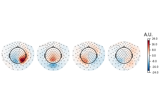mne.time_frequency.psd_array_welch#
- mne.time_frequency.psd_array_welch(x, sfreq, fmin=0, fmax=inf, n_fft=256, n_overlap=0, n_per_seg=None, n_jobs=None, average='mean', window='hamming', remove_dc=True, *, output='power', verbose=None)[source]#
Compute power spectral density (PSD) using Welch’s method.
Welch’s method is described in Welch[1].
- Parameters:
- x
array, shape=(…, n_times) The data to compute PSD from.
- sfreq
float The sampling frequency.
- fmin
float The lower frequency of interest.
- fmax
float The upper frequency of interest.
- n_fft
int The length of FFT used, must be
>= n_per_seg(default: 256). The segments will be zero-padded ifn_fft > n_per_seg.- n_overlap
int The number of points of overlap between segments. Will be adjusted to be <= n_per_seg. The default value is 0.
- n_per_seg
int|None Length of each Welch segment (windowed with a Hamming window). Defaults to None, which sets n_per_seg equal to n_fft.
- n_jobs
int|None The number of jobs to run in parallel. If
-1, it is set to the number of CPU cores. Requires thejoblibpackage.None(default) is a marker for ‘unset’ that will be interpreted asn_jobs=1(sequential execution) unless the call is performed under ajoblib.parallel_configcontext manager that sets another value forn_jobs.- average
str|None How to average the segments. If
mean(default), calculate the arithmetic mean. Ifmedian, calculate the median, corrected for its bias relative to the mean. IfNone, returns the unaggregated segments.New in v0.19.0.
- window
str|float|tuple Windowing function to use. See
scipy.signal.get_window().New in v0.22.0.
- remove_dcbool
If
True, the mean is subtracted from each segment before computing its spectrum.- output
str The format of the returned
psdsarray,'complex'or'power':'power': the power spectral density is returned.'complex': the complex fourier coefficients are returned per window.
New in v1.4.0.
- verbosebool |
str|int|None Control verbosity of the logging output. If
None, use the default verbosity level. See the logging documentation andmne.verbose()for details. Should only be passed as a keyword argument.
- x
- Returns:
- psds
ndarray, shape (…, n_freqs) or (…, n_freqs, n_segments) The power spectral densities. If
average='meanoraverage='median', the returned array will have the same shape as the input data plus an additional frequency dimension. Ifaverage=None, the returned array will have the same shape as the input data plus two additional dimensions corresponding to frequencies and the unaggregated segments, respectively.- freqs
ndarray, shape (n_freqs,) The frequencies.
- psds
Notes
New in v0.14.0.
References
Examples using mne.time_frequency.psd_array_welch#

Compute spatial filters with Spatio-Spectral Decomposition (SSD)
